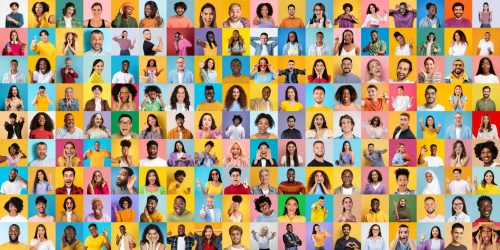‘Inclusion is not a strategy to help people fit into the systems and structures which exist in our societies; it is about transforming those systems and structures to make it better for everyone.’ – Diane Richler (Former President of Inclusion International)
Education is most powerful when it meets learners where they are, addressing their unique needs and contexts. Inclusivity is a cornerstone of this principle, ensuring that every learner has the opportunity to engage with, understand and apply the knowledge they gain. As the shift to digital and hybrid learning environments accelerates, the importance of inclusivity in education has only grown.
Why inclusivity matters
Traditional education models have long relied on standardised content and face-to-face teaching. While these methods have their strengths, they often fall short in fostering a diverse and adaptable system that fully supports students in their learning journey. With the advent of online education, the one-size-fits-all paradigm has given way to opportunities for more personalised and accessible learning. However, this shift also highlights the need for deliberate inclusivity in content design.
Inclusivity in education goes beyond accessibility (i.e. aiding those with reading difficulties, or those living with hearing or visual impairments) – it addresses language barriers, cultural relevance and varying levels of prior knowledge to create equitable learning experiences. Importantly, research shows that students are more motivated and engaged when they see themselves and their realities reflected in their educational content. This relevance is especially critical in diverse contexts like South Africa, where localised examples and culturally aware materials can make the difference between disengagement and empowerment.
The role of local relevance in education
Learning becomes inclusive when it feels relevant. Local relevance bridges the gap between abstract concepts and real-world application, helping learners to connect with the material through their own experiences. Consider the following examples:
- A South African student studying entrepreneurship will grasp business concepts more effectively when case studies are drawn from local businesses rather than from international contexts.
- Learners are more likely to stay motivated and engaged when content reflects their cultural, social and linguistic realities.
Research supports these observations, highlighting the power of locally relevant content in driving student engagement. Aronson and Laughter (2016) demonstrate that tailoring material to resonate with students’ lived experiences not only piques their interest, but also boosts their motivation to learn. Similarly, Kember et al. (2008) found a direct link between content relevance and student motivation: as Petersen (2021) notes in her article on local relevance, ‘students were more motivated to learn when the content was relevant to their lives – and, conversely, they were less motivated when the content lacked relevance’.
Judy Willis (in Bernard, 2010) emphasises another critical benefit: memory retention. She explains that when learners connect new information to their existing knowledge, their neural pathways strengthen, leading to enhanced long-term memory (LTM) storage. In other words, relatable content not only sticks, but also deepens understanding.
Moreover, learning materials with local relevance help students see the practical value of their education. As Theall (n.d.) points out, this connection to real-world contexts empowers learners to grasp how what they’re studying directly applies to their lives, making the learning experience both meaningful and impactful.
How educational institutions can foster inclusivity
Inclusivity is not achieved by chance; it requires intentionality in design and delivery. Here are a few strategies that educational institutions can adopt to make learning inclusive:
- Design for accessibility: Educational content should cater to diverse needs, including for those students with visual, hearing or reading difficulties. In terms of eLearning platforms, this can include features like adjustable text size, subtitles on videos and glossaries in the content.
- Embrace multilingualism: Offering content in multiple languages or providing tools for translation ensures that language barriers do not hinder learning.
- Incorporate cultural sensitivity: Culturally aware content resonates with students by reflecting their lived experiences. This can involve using localised examples, statistics and case studies that are relevant to the students’ communities.
- Scaffold learning: Students come with different levels of prior knowledge. Structured support, such as clear instructions, step-by-step tasks and formative feedback, helps to bridge gaps and builds confidence.
- Multimodal learning tools: Offering content through a mix of formats – visuals, audio, text and interactive elements – ensures that diverse learning preferences are met.
EDGE’s approach to inclusive content
At EDGE, inclusivity is woven into the DNA of our CourseBook™ platform. We take a ground-up approach to content creation, aligning global best practices with the specific needs of South African learners. Here’s how we make it happen:
- Plain language for clarity: We ensure that complex concepts are broken down into clear, understandable language. A list of key terms and definitions at the beginning of each chapter further supports comprehension.
- Localised examples: Our content is rooted in real-world South African contexts, with case studies and activities that reflect the realities of local businesses, communities and cultural nuances.
- Multilingual support: Recognising South Africa’s linguistic diversity, our platform includes a tool for translation and subtitled video content to support non-native English speakers.
- Accessibility for all: EDGE ensures an inclusive learning experience with adjustable text sizes on the CourseBook™ platform to cater to individual visual preferences and needs. Videos are also equipped with subtitles for enhanced comprehension and accessibility.
- Interactive and multimodal design: We incorporate videos, quizzes and other interactive elements to cater to various ways of learning and keep students engaged.
While these practices, features and tools lay a strong foundation, we never stop striving to improve how we deliver content to students. At EDGE, our commitment to innovation drives us to continually refine our methods, ensuring that every student is not just informed, but truly empowered. Our mission is not just to deliver content, but to shape transformative learning experiences that resonate and endure.
2025 and beyond: Building education that connects
As education continues to evolve, inclusivity will be the foundation of meaningful learning experiences. Institutions and content creators must work together to design content that connects with learners – content that is accessible, relevant and reflective of their unique contexts.
At EDGE, we believe that inclusive education is not just a goal, but a necessity. By prioritising local relevance and learner-centred design, we are helping to shape a future where education is a bridge to opportunity for all. Because when learning connects, it transforms.
References
Aronson, B. and Laughter, J. (2016), ‘The Theory and Practice of Culturally Relevant Education: A Synthesis of Research Across Content Areas’. Review of Educational Research 86(1): 163–206.
Bernard, S. (2010), ‘Science Shows Making Lessons Relevant Really Matters’. Edutopia [website] <https://www.edutopia.org/neuroscience-brain-based-learning-relevance-improves-engagement> accessed 15 November 2020.
Bloom, B. S. (1976), Human Characteristics and School Learning. New York, NY: McGraw-Hill Education, p. 7.
Kember, D., Ho, A. and Hong, C. (2008), ‘The importance of establishing relevance in motivating student learning’. Active Learning in Higher Education 9(3): 249–263.
Petersen, C. (2021), ‘Local relevance: A key factor in learner engagement and motivation’. EDGE Education [website] <https://edgeeducation.com/local-relevance-a-key-factor/> accessed 8 January 2025.
Theall, M. ‘Related course material to real-life situations’. IDEA [website] <https://www.ideaedu.org/idea-notes-on-instruction/related-course-material-to-real-life-situations/> accessed 24 November 2020.



